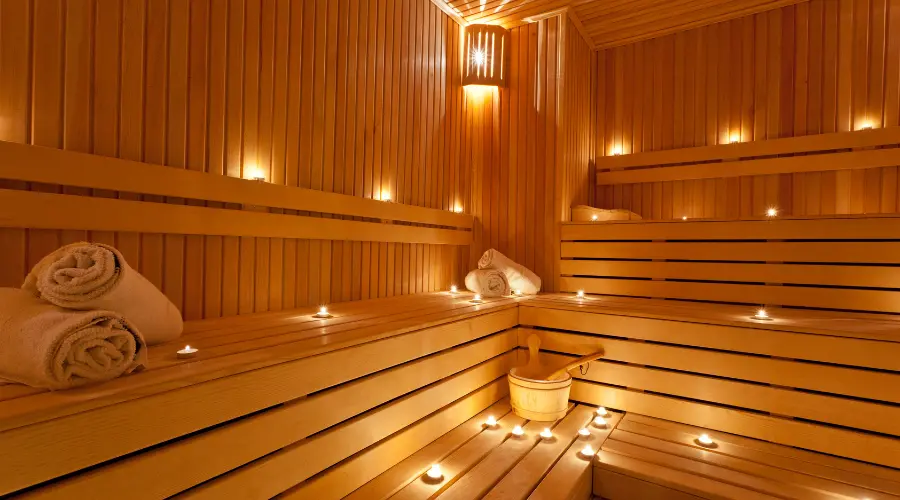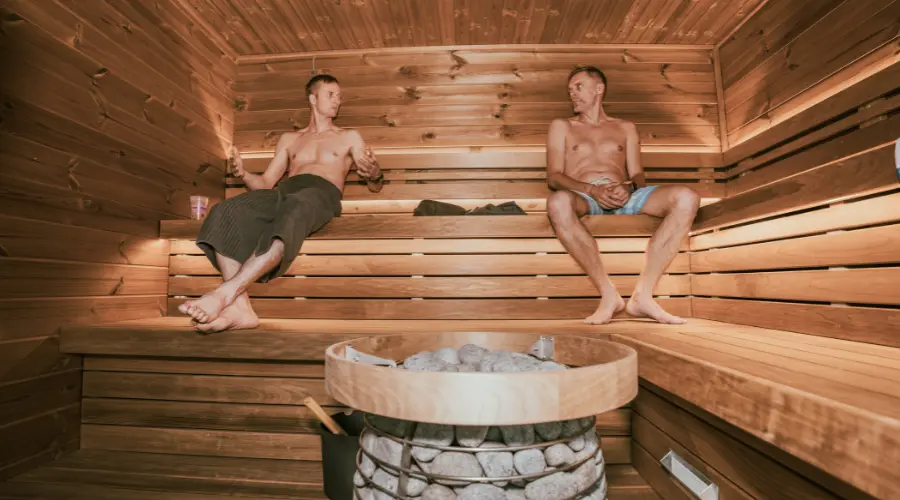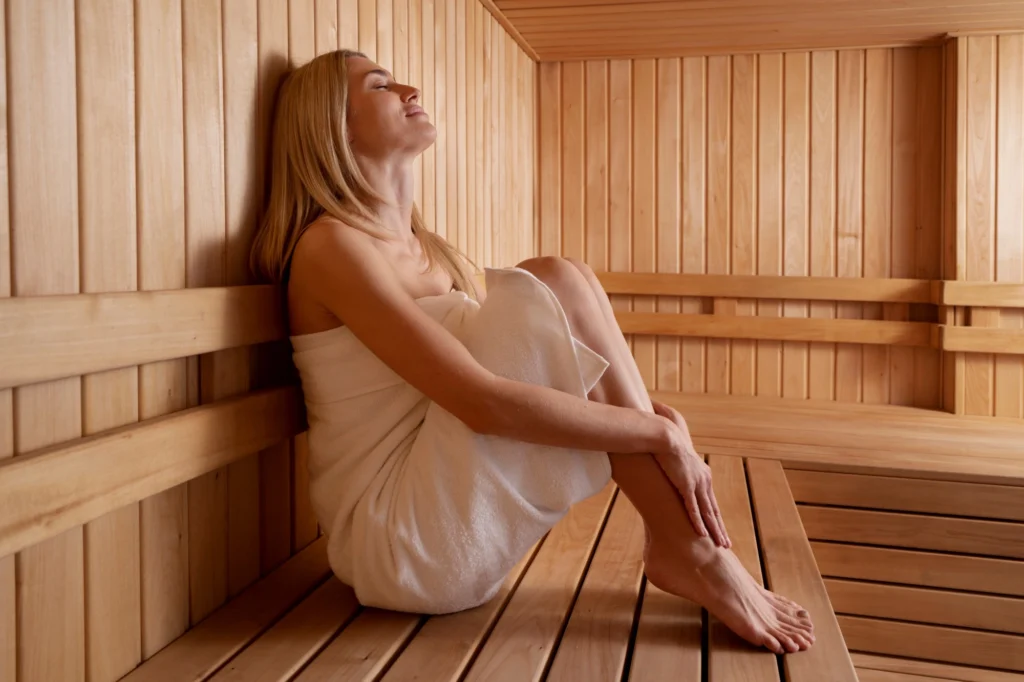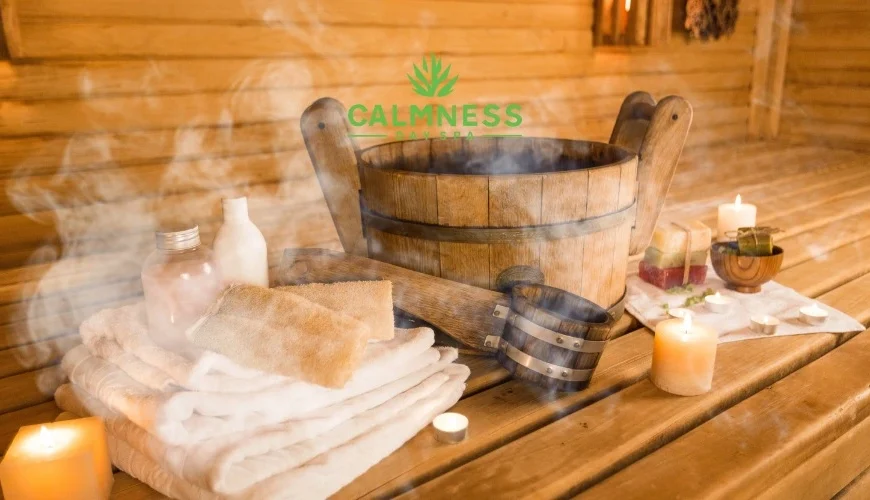In a world full of stress, tight schedules, and digital overload, maintaining healthy blood pressure has become the major focus of many. While exercise, nutrition, and lifestyle changes remain key to managing hypertension, natural wellness practices such as sauna & steam therapies are gaining attention worldwide.
Spending just 20 minutes in the sauna and steam can work wonders, not only for relaxation but also in improving circulation and lowering blood pressure naturally. This combination of heat, humidity, and deep relaxation sparks strong physiological responses that have numerous benefits for the heart and body.
If you have ever wondered how a short session in a sauna near Pokhara can make you feel refreshed, lighter, and calmer, then you are going to be surprised to learn that it is not just psychological but rather scientific.
Understanding Sauna & Steam Therapy

Before discussing the health benefits of sauna & steam, it is essential to understand what sauna & steam therapy are and how they work. While both offer relaxation and detoxification, the methods and physiological impacts differ, making them complementary in terms of heat therapy to support cardiovascular health and lower blood pressure naturally.
Sauna – The Dry Heat Chamber
The sauna itself is a dry-heat environment, intended to gradually raise your body temperature. More traditional versions were heated by wood-burning stoves, but many saunas today are electronically heated or use infrared technology to warm the surrounding air and physical surfaces. A typical sauna ranges from about 70°C to 100°C, and thus results in a very intense and dry heat, with very low humidity.
When you’re sitting in a sauna, the temperature of your skin can rise several degrees within minutes. Your body immediately starts to sweat and cool you down through heavy perspiration, which releases toxins and extra sodium. Your heart rate increases-sometimes by up to 30% of your normal resting rate-this mildly works your cardiovascular system, much like light aerobic exercise would do. The improved circulation and increased oxygen supply strengthen your heart over time.
Sauna dry heat also stimulates the release of endorphins, which induce deep relaxation and result in lower blood pressure. Many people find their time in the sauna to be similar to meditation: the gentle warmth, the quiet, and the rhythmic breathing all work to still the nervous system and renew the mind.
A sauna in the vicinity of Pokhara is a great way to relax for the travelers and wellness professionals after a long trek or hard physical work. The mountain air outside and the dry heat inside create a beautiful balance of refreshment and relaxation.
Steam Room – The Moist Heat Experience
A steam room, on the other hand, provides a different kind of heat-a moist one. As opposed to the dry atmosphere of a sauna, the sauna steam room generates mist in the air with the use of boiling water or a steam generator to fill it up, creating almost 100% humidity at a much lower temperature of around 45-50°C.
Although the air seems milder than in a sauna, because of the steam, the effect of heat is more intense on the skin. The warmth and humidity open pores, soften skin, and promote deeper cleansing to extract impurities, leaving the skin hydrated and glowing.
From a health perspective, steam therapy is great for the respiratory system. The warm, moist air soothes the nasal passages, clears the sinuses, and enables breathing more easily for people with asthma or allergic reactions. Steam maintains blood circulation and relaxes muscles, hence being very good for getting rid of tension, stiffness, and fatigue.
One of the most remarkable benefits of sauna & steam involves the detoxifying effect of a steam room. While it makes your body sweat in that moist atmosphere, it removes toxins through the skin and supports hydration. All this natural cleansing contributes to kidney and liver function and helps your body maintain blood pressure at a balanced level.
Sauna and Steam: A Perfect Balance

While both sauna & steam rooms have their various benefits, the combination of both can indeed be more powerful in effecting wellness. Most wellness centers and spas, especially those offering sauna near Pokhara, offer both facilities to enable visitors to enjoy the best of both worlds.
Here’s how they complement each other:
Sauna (Dry Heat): Improves blood circulation, burns calories, strengthens the heart, and supports lower blood pressure.
Steam Room: Moist heat promotes detoxification, soothes the skin, improves breathing, and relaxes the nervous system.
Alternating between the two-what’s called contrast therapy-forces your blood vessels to dilate and then contract, which strengthens vascular elasticity and the heart in general. It will allow your body to adapt more quickly to further changes in temperature and stress, therefore being beneficial in maintaining cardiovascular health in the long term.
Most athletes and wellness enthusiasts use sauna and steam alternately for optimal recovery and performance. While the dry heat of the sauna works to activate deep muscle relaxation and improves your circulation, the steam replenishes moisture, clears toxins from your body, and leaves you feeling lightweight and energized.
If you’re looking into wellness options in Nepal, taking some time for a sauna & steam session in Pokhara will be very relaxing and restorative. The serenity outside and the heat’s therapeutic effect provide relief that is not just physical but also helps balance your emotions and mind, which are the key ingredients for a healthy heart and stable blood pressure.
1. Sauna and Steam Improve Circulation
Sauna heat causes vasodilation, which is the expansion of blood vessels. This lowers blood pressure within your arteries, making it easier for blood to circulate. Regular sauna steam sessions, over time, can equalize blood pressure and heart efficiency in general.
Steam rooms enhance this process by raising the moisture in the air, further helping your lungs and skin take in more oxygen. The combination of sauna and steam encourages better oxygen flow within your body to aid in relaxation and detoxification.
2. Reduces Stress and Cortisol Levels
One of the more common causes of high blood pressure is chronic stress. Modern living often keeps our bodies in “fight or flight” mode and elevates cortisol, the stress hormone.
Spending time in a sauna near Pokhara allows your body and mind to unwind. The gentle heat relaxes tense muscles and triggers the release of endorphins — your body’s natural “feel-good” chemicals. As your mind calms, cortisol levels drop, helping you lower blood pressure naturally.
Regular sauna & steam therapy can even help in improving sleep quality, which is another essential factor for managing stress-related hypertension.
3. Detoxification by Sweating
Sweating is the natural detoxification system of your body. You are able to detoxify from toxins, sodium, and heavy metals that cause fluid retention and high blood pressure by sweating in a sauna steam environment.
A 20-minute sauna session will help you flush impurities through your skin and support kidney and liver detoxification, which will improve metabolic balance and deliver better cardiovascular function.
This cleansing process helps your internal organs, and it also improves your skin texture and gives you a fresh and radiant glow.
4. Strengthening the Heart Like Mild Exercise
A sauna session can elevate your heart rate to the level of light aerobic workouts. In addition, it can raise your pulse from 70 beats per minute to over 100 — thus training your cardiovascular system and improving oxygen efficiency.
This is similar to the effect caused by brisk walking or light cycling. With time, frequent exposure to sauna & steam heat conditions the heart to perform its function more efficiently and can encourage long-term lowering of blood pressure.
5. Improves Blood Vessel Flexibility
Another advantage of sauna and steam therapy is vessel elasticity. The heating of the arteries expands them and, over time, encourages flexibility. Flexible vessels react well to changes in blood flow, reducing the risks of hypertension.
Studies have shown that frequent users of saunas have reduced systolic and diastolic blood pressure levels compared with non-users.
6. It balances the nervous system.
Your autonomic nervous system controls many involuntary functions, including heart rate and blood pressure. Chronic stress can throw this system off balance, leading to hypertension.
The heat from the steam therapy in a sauna helps rebalance the body by shifting from ‘fight or flight’ mode into ‘rest and digest’. This has a calming effect, which helps your heart relax and work efficiently.
7. Reduces inflammation within the body.
Inflammation is a silent contributor to hypertension and cardiovascular disease. Regular sessions of sauna & steam help decrease the level of inflammatory markers by increasing circulation and activating white blood cells.
This combination of heat exposure and detoxification stimulates the immune system, reduces inflammation, and helps vascular health in general.
8. Complementary Benefits of Sauna & Steam
For Skin and Respiratory Health
Besides the heart health benefits, sauna & steam sessions promote good, healthy skin by opening up the pores and getting rid of impurities. Steam inhalation helps clear up congestion, clean sinuses, and facilitate breathing.
For Muscle and Joint Recovery
Visiting a sauna near Pokhara is one of the best recovery methods after an intense workout or trekking in rugged Nepal. The heat relaxes tight muscles, reduces soreness, and improves flexibility.
This is why many spas and gyms in Pokhara suggest doing alternate sauna & steam sessions after exercise for complete relaxation.
How Long Should You Stay in a Sauna or Steam Room?

For sauna & steam therapy, the best consideration is moderation. As much as the experience can be truly relaxing and helpful for your heart and mind, overexposure can indeed lead to dehydration or fatigue. The time of the session must depend on your body’s tolerance, experience level, and overall health condition.
Start Slow and Build Up Gradually
For beginners, especially, the tendency is to start slow. Spend 10 to 15 minutes in the session to allow your body to get accustomed to the heat and humidity. When this becomes easy and one feels comfortable at such a temperature, then the time may be increased to 20 minutes per session, the optimal duration for most adults to gain the full cardiovascular and relaxation benefits.
Even for experienced users, the session should not last more than 25 minutes continuously, as this could lead to dehydration and overheating. The aim is to be refreshed and rejuvenated, never exhausted.
Pre-Session Preparation
Before entering the sauna, acclimate your body to the heat:
Hydrate well: Drink a glass or two of water before your session. Hydration supports sweating and prevents dizziness.
Avoid heavy meals: Give your body a minimum of an hour after eating before entering the sauna. A full stomach can make you feel uncomfortable and lethargic.
Wear light or no clothes at all: Many saunas require customers to use a towel or light clothes that enable the skin to breathe well.
During the Session
Once inside the sauna steam room, take deep breaths and allow your body to relax. A combination of warmth and calmness increases blood circulation, helping to lower blood pressure naturally. However, it’s very crucial to listen to your body:
If you start to feel dizzy, lightheaded, or uncomfortably hot, step out immediately and cool down.
Avoid talking excessively or using mobile phones, and enjoy this time for peace and deep relaxation.
After the Session
After your sauna & steam session, your body continues to sweat as it cools down. This is an important part of your detoxification process, so don’t forget to:
Cool down gradually: Sit or lie down in a cool room for a few minutes before showering.
Hydrate: Replenish lost minerals with plenty of water or fluids high in electrolytes.
Rest: Give your body time to recover before engaging in physical activities.
A balanced approach ensures maximum benefit without overstressing your cardiovascular system.
Best Time to Enjoy Sauna & Steam
Timing can be everything when it comes to your sauna and steam session. The best time is determined by what you are trying to achieve: whether it’s boosting your morning, relieving post-workout soreness, or calming down before bed.
Post-Workout Recovery
After exercise, a sauna steam session may be particularly rewarding. It relaxes the sore muscles, improves circulation, and quickens the body’s recovery process. Dry heat from the sauna helps to increase oxygen flow to tired muscles, while the steam hydrates tissues and flushes out lactic acid.
Evening Relaxation
If you intend to relieve stress and relax, the optimal time for taking a sauna & steam is in the evening. The mild heat comforts the nervous system, relaxes muscles, and prepares the body for a sound sleep. Many people find that evening sessions help them unwind from the day’s mental and physical strain.
After Trekking or Hiking
Visiting a sauna near Pokhara, especially for those going to Nepal or the adventurous region of Pokhara, is perfect after a long trek or outdoor activity. The contrast of the cool mountain air with the warm atmosphere of the sauna is deeply satisfying, restoring your energy and helping to naturally lower blood pressure.
So, whether for recovery, relaxation, or rejuvenation, timing your sauna steam therapy just right will amplify its advantages tenfold.
Precautions and Safety Tips
While generally harmless, sauna & steam therapy do require some responsible practice to make sure you are reaping all the benefits without any adverse side effects.
Important Safety Guidelines
- Consult your doctor: If you have heart disease, high blood pressure, or other medical conditions, seek the advice of a physician before starting sauna therapy.
- Hydrate yourself: Drink water before and after your session. Dehydration can cause dizziness and fatigue.
- Avoid alcohol and caffeine; they dehydrate the body and increase heart rate, which works against relaxation from sauna steam.
- Cool down slowly: Avoid bustling from hot into cold; allow your body to adjust gradually.
- Time limit: Do not exceed 20–25 minutes in the sauna at one time.
- Skip if unwell: Do not use a sauna when you have a fever, inflammation, or any kind of disease that may cause dehydration.
Safety and moderation are the keys to fully reaping the cardiovascular and mental wellness benefits of sauna &steam.
Sauna near Pokhara – Relax, rejuvenate, and heal naturally.
Rarely does any place in the world offer peace and scenic beauty as Pokhara does. Surrounded by lakes, lush hills, and panoramic Himalayan views, this peaceful city is not only a trekker’s paradise but also a growing wellness destination. If you want a genuine relaxation experience, trying a sauna near Pokhara should be at the top of your list.
The Pokhara Sauna Experience
The wellness centers and spas in Pokhara cleverly amalgamate modern facilities with traditional modes of healing. Most of them boast sauna & steam therapies coupled with Himalayan herbs or essential oils, and even salt-infused steam, to enhance the levels of relaxation and detoxification.
Imagine entering a sauna steam room on a chilly morning after a hike, feeling your muscles loosen, your breathing slow, and your mind coming to stillness. That’s what sauna therapy in Pokhara is all about: the perfect blend of nature and serenity, rejuvenation at its best.
Regular visits to a sauna near Pokhara not only provide a soothing escape from daily stress but also contribute to long-term wellness. The consistent use of sauna & steam therapy can support healthy circulation, aid muscle recovery, and help lower blood pressure naturally.
More Lifestyle Changes to Reduce Blood Pressure
While sauna and steam therapy provide impressive benefits for the cardiovascular system and relaxation, combining them with healthy lifestyle choices will amplify the results. Here are ways to make your wellness journey even more effective:
1. Stay Active
Perform light or moderate exercise, like walking, yoga, swimming, and cycling. Exercises like these will keep your heart strong and your blood circulating well, enhancing the effects of sauna steam sessions.
2. Eat Mindfully
Nutrition is critical to maintaining healthy blood pressure. Emphasize fresh fruits, leafy vegetables, whole grains, lean proteins, and low-sodium foods. Limit processed foods and include potassium-rich items like bananas and avocados, which balance the salt intake.
3. Hydrate
Always drink enough water, especially before and after a sauna session. Proper hydration supports sweating and detoxification and ensures stable blood pressure levels.
4. Sleep Well
Quality sleep is an important component in ensuring good cardiovascular health. Get 7 to 8 hours of continuous sleep each night to help your body recover and regulate the hormones associated with stress.
5. Limit Alcohol and Tobacco
Alcohol and tobacco increase blood pressure and offset the beneficial aspects of sauna & steam therapy. Reduced or eliminated, these habits contribute to heart health and increased energy.
6. Practice mindfulness
Techniques like meditation, deep breathing, or gratitude journaling help in relaxing the nervous system and decreasing the level of stress. Combining mindfulness with sauna steam therapy enhances relaxation and emotional well-being.
7. Be Consistent
Consistency is key. Keeping up a regular sauna near Pokhara or even following a diet will provide sustainable improvements in health and mood over time.
Conclusion
In addition, including sauna and steam therapy in your wellness routine is not just a luxury, but one supported by science to help lower blood pressure, improve circulation, and support overall well-being. The use of sauna & steam for only 20 minutes can stimulate the body’s natural processes for relaxation, detoxification, and cardiovascular balance.
The dry heat of the sauna strengthens the heart, develops a deeper flow of blood, and simulates light exercise, while the moist heat in the steam room soothes muscles, clears the lungs, and deeply hydrates the skin. In this way, both therapies together provide an excellent synergistic effect that enhances physical and mental well-being.
Well, during a visit to Nepal, this is something one must experience near Pokhara. Against the serene backdrop of the Himalayas, these wellness centers offer an authentic means of relaxation and natural rejuvenation. Be it after a long trek, after a workout, or simply to relieve stress caused by the daily grind, sauna steam in Pokhara offers holistic benefits beyond mere relaxation-it supports heart health and naturally normalizes blood pressure.
Come relax your mind, strengthen your heart, and find a natural way to lower blood pressure with today’s 20 minutes of sauna & steam.
FAQs
What is better, sauna or steam?
Neither a sauna nor a steam room is definitely “better,” as the best choice will depend on your personal health goals and preferences for dry or moist heat. Saunas use dry heat and are often better for cardiovascular and muscle recovery, while steam rooms use moist heat and are better for skin hydration and respiratory comfort. Both have similar general health benefits, such as improved circulation and reduced stress, and can be soothing.
Should you do sauna or steam first?
It is typically recommended to start with a sauna to gradually warm up your body, followed by a steam room to thoroughly cleanse and hydrate your skin. However, your personal preferences and goals will dictate the best order. While the dry heat of a sauna is beneficial for gradual muscle relaxation and pore opening, the moist heat of a steam room is beneficial for hydrating the skin and respiratory system.
Are steam and sauna good for skin?
Indeed, steam and saunas can help skin and produce a clearer, healthier, and more radiant complexion by opening pores, promoting cleansing, enhancing circulation, and promoting collagen synthesis. Moderation and proper skincare are essential because overuse can result in irritation and dryness.
Can I do sauna and steam together?
Steam and sauna can be combined, either sequentially or by alternating between them. Alternating between the dry heat of a sauna and the wet heat of a steam room can enhance benefits like improved circulation, muscle relaxation, and skin cleansing.
Are sauna and steam good for blood pressure?
Yes, the heat in steam rooms and saunas causes blood vessels to widen, which enhances circulation and lowers blood pressure.

